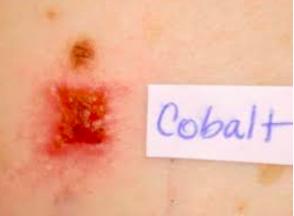Contrary to what the Food Babe says, the spelling, length, or pronunciation of a chemical has absolutely nothing to do with its health properties, good, bad, or neither. Even a scary name means nothing. Consider three names for the chemical below. They are all correct.

If there is anything scary sounding about any of them, most people would pick:
CYANOcobalamin.
But they'd be wrong. Despite one molecule of cyanide there isn't a whole lot to be scared about Vitamin B12, but in rare circumstances, it is this:
CyanoCOBALamine (COBAL being short for the metal cobalt). Although cobalt-containing biomolecules are rare in nature, cyanocobalamin is structurally very similar to two other common organometallic (1) molecules, heme, and chlorophyll (Figure 1).

Figure 1. Biologically important metal coordination complexes: (Left) Cyanocobalamin, one of the forms of Vitamin B12. (Cobalt is in the blue circle, cyanide in the red circle). (Center) Heme, the "business end" of hemoglobin (Iron is in the red circle). (Right) Partial structure of chlorophyll (Magnesium is in the green circle). Note that in all three molecules metal ions are coordinated - held in the middle - of four nitrogen atoms (yellow stars) which are part of five-membered rings. This motif is nature's way of binding organic metals to metals.
Vitamin B12 is essential for every cell in the human body (animals too), so it may seem strange, but some people are allergic to it and they can suffer either an acute or chronic itchy rash that can have small blisters containing a clear fluid, skin that is red, swollen, oozing, or peeling. A cobalt allergy can be confirmed by a skin patch test (Figure 2).

Figure 2. A cobalt skin patch test. Source: Derm Net NZ
Why would anyone be allergic to cobalt? Chemistry gives us an answer. Figure 3 shows a cobalt skin patch test that also includes nickel. Perhaps the nickel reaction is even more pronounced than that from cobalt. This shouldn't be too surprising since nickel happens to be a known skin allergen and a cause of eczema and contact dermatitis. And nickel just happens to reside right next to cobalt on the periodic table.
"Nickel allergy is a common cause of allergic contact dermatitis — an itchy rash that appears where your skin touches a usually harmless substance... It may take repeated or prolonged exposure to items containing nickel to develop a nickel allergy. Treatments can reduce the symptoms of nickel allergy. Once you develop a nickel allergy, however, you'll always be sensitive to the metal and need to avoid contact."
Mayo Clinic

Figure 3. (Left) A skin patch test showing allergies to both cobalt and nickel. Source: Nritya Creations (Right) Cobalt and nickel are neighbors on the periodic table. The two metals have similar properties. Furthermore, allergy to multiple metals and metal alloys has been demonstrated.
So, people who are allergic to B12 are actually reacting to the presence of cobalt, which is similar in properties to nickel - a known allergen. What about people who are B12 deficient but also allergic to cobalt? They cannot avoid the cobalt since it is part of the vitamin. The general advice seems to be "take just enough but not too much," which isn't too different from dosing advice for all vitamins and drugs.

Nickel dermatitis. Source: Authoritycure
NOTE:
(1) Organometallic chemicals contain at least one covalent bond between a carbon atom and a metal. Some are stable and benign, some ignite when exposed to air, and one of them is so dangerous that it killed a chemist who spilled a tiny amount on the back of her glove. (See Two Drops Of Death: Dimethylmercury)




